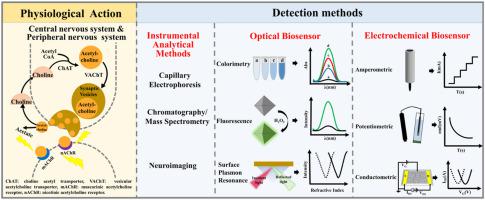Analytical Biochemistry Pub Date : 2021-09-14 , DOI: 10.1016/j.ab.2021.114381 Xuan Gu 1 , Xiaoying Wang 1

|
Acetylcholine (ACh), the major neurotransmitter secreted by cholinergic neurons, is widely found in the peripheral and central nervous systems, and its main function is to complete the transmission of neural signals. When cholinergic neurons are impaired, the synthesis and decomposition of ACh are abnormal and the neural signalling transition is blocked. To some extent, the concentration changes of ACh reflects the occurrence and development of many kinds of nervous system diseases, such as Alzheimer's disease, Parkinson's disease, Myasthenia gravis and so on. Thus, researches of the physiological and pathological roles and the tracking of the concentration changes of ACh in vivo are significant to the prevention and treatment of these diseases. In the paper, the pathophysiological functions and the comprehensive research progress on detection methods of ACh are summarized. Specifically, the latest research and related applications of the optical and electrochemical biosensors are described, and the future development directions and challenges are prospected, which provides a reference for the detection and applications of ACh.
中文翻译:

乙酰胆碱近期分析检测综述
乙酰胆碱(ACh)是胆碱能神经元分泌的主要神经递质,广泛存在于外周和中枢神经系统,其主要功能是完成神经信号的传递。当胆碱能神经元受损时,ACh的合成和分解异常,神经信号传导受阻。ACh的浓度变化在一定程度上反映了多种神经系统疾病的发生和发展,如阿尔茨海默病、帕金森病、重症肌无力等。因此,研究乙酰胆碱的生理和病理作用,追踪体内乙酰胆碱浓度的变化,对预防和治疗这些疾病具有重要意义。在论文中,综述了乙酰胆碱的病理生理功能和检测方法的综合研究进展。具体阐述了光学和电化学生物传感器的最新研究和相关应用,展望了未来的发展方向和挑战,为乙酰胆碱的检测和应用提供参考。


















































 京公网安备 11010802027423号
京公网安备 11010802027423号